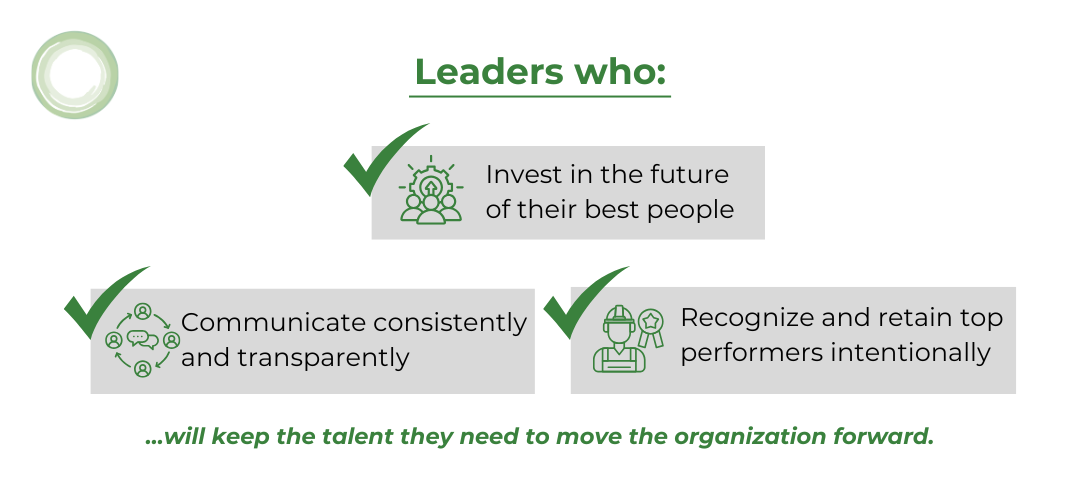High-performing employees always have options, making retaining top talent an important focus for leaders.
And during times of transition—whether driven by mergers, restructuring, or leadership shifts—those options become even more attractive.
It’s not just about job security. Top performers start asking themselves:
- Do I still have a clear future here?
- Can I trust leadership to guide us through uncertainty?
- Does my work matter amid all the change?

If leaders can’t offer compelling answers, high-potential employees will look elsewhere– here’s how to guide them into growth.
Retention isn’t an HR function—it’s a leadership responsibility. Here’s how to keep your top talent engaged and committed, especially when the organization is in flux.
1. Invest in Leadership Development to Retain Top Talent.
Employees don’t leave companies; they leave when they no longer see a future for themselves.
Change often disrupts that sense of clarity. If advancement opportunities aren’t visible, your top performers won’t wait for leadership to figure it out.
Three ways to make leadership development a retention strategy:
- Launch a Leadership Fast-Track Program: Identify high-potential talent and actively invest in their growth—through executive mentorship, stretch assignments, and cross-functional leadership opportunities.
- Offer Shadow Leadership Assignments: Give key employees exposure to board meetings, C-suite strategy sessions, or critical business decisions. Access to the future of the organization strengthens long-term commitment.
- Prioritize Internal Mobility: Don’t make employees search for their next role. Proactively match them with opportunities aligned to their strengths and aspirations.
Case Study: Stopping Post-Acquisition Turnover
A private equity-backed manufacturing firm faced significant leadership departures after an acquisition. Senior leaders were leaving, frustrated by a lack of clarity.
The solution? A structured leadership acceleration program that provided a defined 18-month growth roadmap for key talent. Retention stabilized and long-term engagement increased.
The takeaway: If your top performers can’t see a future with you, they’ll find one somewhere else.
Want to help your leaders navigate change more effectively? Take the Engaged Team Health Quiz to assess your team’s leadership engagement.
2. Prevent Uncertainty: Strengthen Retention with Transparent Communication
Uncertainty fuels worst-case assumptions.
When leaders stay silent, employees don’t fill the void with patience. they fill it with doubt. Retaining top talent starts with building trust and building trust starts with visibility—executive presence helps leaders project calm and clarity during transitions.
The most effective retention strategy is clear communication before rumors take over.
Three ways to ensure transparency builds trust, not confusion:
- Set the Narrative Early: If employees learn about organizational changes through external sources before leadership addresses them, trust erodes. Be the first to communicate.
- Commit to a Communication Cadence: Weekly executive updates, biweekly town halls, and small-group Q&A sessions prevent information vacuums from becoming trust gaps.
- Make Leadership Accessible: A monthly 30-minute “CEO Open Forum” creates direct access to leadership and reinforces transparency as a priority.
Case Study: How Transparent Leadership Drives Retention
Organizations with high-trust cultures experience turnover rates 50% lower than their peers.
McKinsey research shows that organizational transformations are 5.8 times more likely to succeed when CEOs communicate a compelling vision and a clear change story.
Help your executive team master transparency and trust. Learn how The Leadership EDGE supports teams through transformation.

The takeaway: If you don’t control the narrative, employees will write their own. And that story rarely works in leadership’s favor
3. Make Retention Personal: Strategic Recognition That Drives Commitment
Retention isn’t solely about career advancement. It’s also about whether employees feel seen, valued, and recognized—especially during periods of transition. Recognition goes beyond bonuses—it’s about emotional insight. Emotional intelligence helps leaders understand what really matters to their people.
In times of change, top performers often take on additional responsibilities and stabilize the business. If their contributions go unnoticed, loyalty disappears quickly.
Three ways to use recognition strategically:
- Use Targeted Retention Incentives: Move beyond blanket bonuses. Offer performance-based equity, deferred compensation, or long-term incentive programs (LTIPs) that reward sustained contributions. Private equity firms leveraging LTIPs see a significant drop in post-acquisition executive turnover.
- Give High Performers a Stake in the Future: In consulting and professional services, high producers often leave when excluded from strategic decisions. Involve them directly—whether through leadership roles, client continuity, or transition planning.
- Go Beyond Financial Rewards: Money matters, but autonomy, visibility, and challenge matter just as much. Assign top performers to high-profile initiatives and innovation projects.
Case Study: The ROI of Recognition
A Gallup study found that employees who feel recognized are 56% less likely to explore other job opportunities.
The takeaway: Recognition isn’t just about appreciation—it’s a critical leadership strategy that drives retention and long-term engagement.
Want to motivate your team in a way that truly resonates? Explore our Enneagram Applied course to learn how to lead through individual motivation types.
Final Thought: Retention Is a Leadership Responsibility
Losing key talent during change isn’t inevitable. It’s a reflection of how leaders navigate uncertainty.
Leaders who:
- Invest in the future of their best people
- Communicate consistently and transparently
- Recognize and retain top performers intentionally
…will keep the talent they need to move the organization forward.

If your organization is undergoing a transition, retention isn’t something to leave to chance.
At Meritage Leadership, we help executive teams design strategies that strengthen trust, retain top talent, and position organizations for long-term success.
Let’s talk about how to build a retention strategy that works. Contact us to explore bespoke solutions tailored to your team, cohort, or entire organization. Or, if you’re a leader looking to grow your influence during change, take the the Leadership Superpower & Roadblock Assessment to uncover your blindspots.


